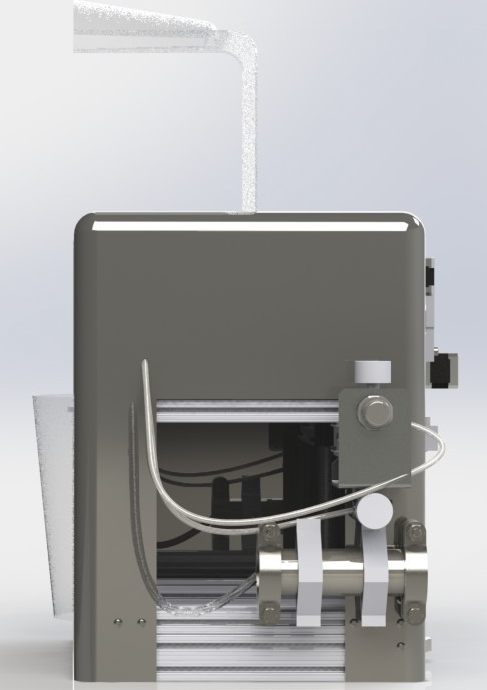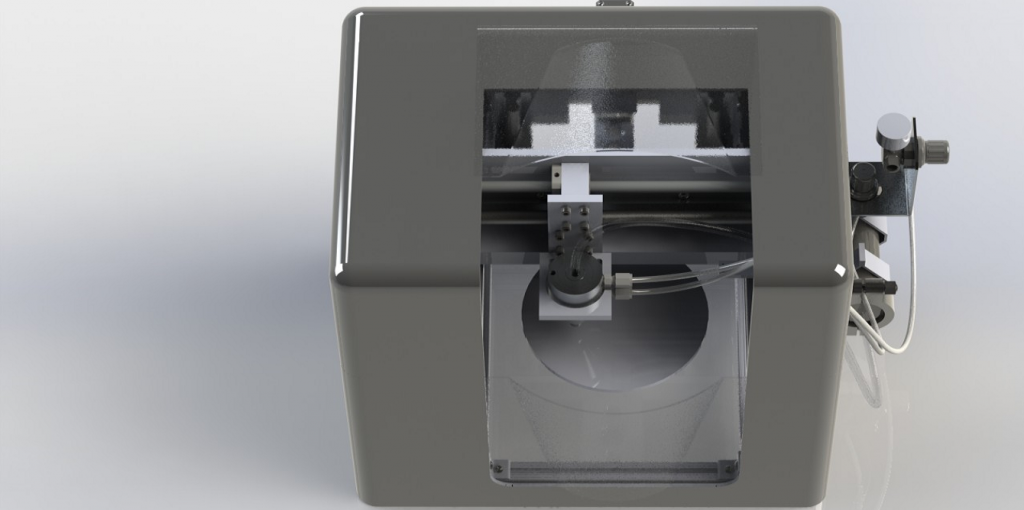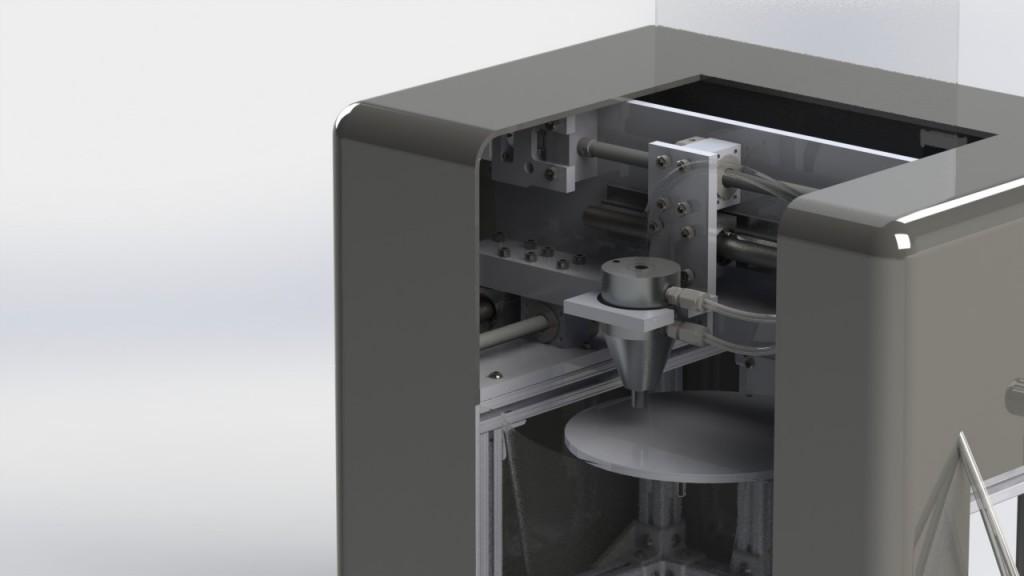HDFab 3D Printer Unveiled: Capable of Printing Advanced Materials Using New Pressurized Spray Technology
This has already been a big year within the 3D printing industry. We’ve seen numerous new technologies as well as materials emerge as print speeds increase, prices decrease, and the number of machines sold skyrockets.
One company which is making waves within the space is HotEnd Works, a company who thrives on pushing the limits of advanced materials. They have recently unveiled a new patent pending  method of printing called Pressurized Spray Technology (PSD), which is inherent in their soon-to-launch 3D printer, the HDfab. Utilizing this new technique, HotEnd Works is able to rapidly fabricate objects using advanced materials and ceramics such as alumina (AL2O3), zirconia (ZrO2), zluminum nitride (AlN), tungsten carbide (WC), silicon carbide (SiC), boron carbide (B4C), and a variety of ceramic-metal matrices.
method of printing called Pressurized Spray Technology (PSD), which is inherent in their soon-to-launch 3D printer, the HDfab. Utilizing this new technique, HotEnd Works is able to rapidly fabricate objects using advanced materials and ceramics such as alumina (AL2O3), zirconia (ZrO2), zluminum nitride (AlN), tungsten carbide (WC), silicon carbide (SiC), boron carbide (B4C), and a variety of ceramic-metal matrices.
“The PSD™ technology was developed from my and my team’s experience with spray technology while working in the industry,” explained Benjamin Becker, Managing Director of the Oberlin, Ohio-based company. “We had been working on a thermoplastic-based binder system to incorporate powdered advanced materials for extrusion. When we discovered the inherent disadvantages of the extrusion method, such as voids within a component and the ‘stair-stepping’ effect, we drew on our spray technology experience and came up with the jetting nozzle that is used with the PSD™ technology. The idea is that the parent material being jetted, such as an advanced ceramic, has a high enough velocity to embed itself into the previously deposited layer, forming a stronger, more dense part.”
The PSD process, which is explained in greater detail here, works by using two different materials during the fabrication process — a main parent material and then a polymeric binding material.  The binding material is pretty much for temporary support and adhesion of the parent material, and it can be removed using a heated finishing process. The majority of materials which have melting points over 250ºC can be used with this process, and the parts which are fabricated with the HDfab 3D printer are incredibly dense. This means no fillers are required, and the parts are pure. Not only is quality one of the outcomes of this new process, but it can all be done at speeds which seem almost unfathomable within the high-end additive manufacturing space. Becker tells us that his machines can dispense material at a rate of 2.5 cc/min, and would be perfect for numerous industries which rely on the manufacturing of components and prototypes using advanced materials.
The binding material is pretty much for temporary support and adhesion of the parent material, and it can be removed using a heated finishing process. The majority of materials which have melting points over 250ºC can be used with this process, and the parts which are fabricated with the HDfab 3D printer are incredibly dense. This means no fillers are required, and the parts are pure. Not only is quality one of the outcomes of this new process, but it can all be done at speeds which seem almost unfathomable within the high-end additive manufacturing space. Becker tells us that his machines can dispense material at a rate of 2.5 cc/min, and would be perfect for numerous industries which rely on the manufacturing of components and prototypes using advanced materials.
“Every industry uses advanced materials,” Becker told 3DPrint.com. “I would say our biggest feedback has been from the Defense, Aerospace, and High Technology sectors. We’ve also worked with consumer goods companies as well as the price to manufacture components using our system is often less than traditional advanced material manufacturing methods, while allowing for more freedom during the design process.”
Becker expects that the HDfab printer will be released early next year at a price of around $55,000 per unit. The machine, which is the product of years of research and development, will likely be  shipped with a build envelope of 8 x 8 x 8 inches, although Becker tells us that the system is incredibly easy to scale, so larger machines are feasible as well.
shipped with a build envelope of 8 x 8 x 8 inches, although Becker tells us that the system is incredibly easy to scale, so larger machines are feasible as well.
“I became involved in the 3D printing scene because of the lead times and pricing, specifically within the advanced ceramics industry,” Becker told us. “Some parts the size of a half dollar would cost $500 in large quantities, and we would be waiting 12 weeks. That’s when it hit me that there needed to be an additive manufacturing solution for advanced materials, and that the comfortable, almost collusion-like advanced ceramics market needed a wakeup call. In my now day-to-day world, I like handling the business side of our company, as well as getting my hands dirty in the lab building up our next prototype. I’ve been working with many high-profile customers, many of which I’m unable to disclose, to develop this technology since 2013.”
The company is currently seeking series A investment funding so that they “can grow within the trillion dollar advanced materials market.” If this machine is capable of what HotEnd Works says it is, investment is not something that will be difficult finding.
Let us know your thoughts on this new 3D printing process and subsequent soon-to-launch printer. Discuss in the HDfab 3D printer forum thread on 3DPB.com.
Subscribe to Our Email Newsletter
Stay up-to-date on all the latest news from the 3D printing industry and receive information and offers from third party vendors.
You May Also Like
Profiling a Construction 3D Printing Pioneer: US Army Corps of Engineers’ Megan Kreiger
The world of construction 3D printing is still so new that the true experts can probably be counted on two hands. Among them is Megan Kreiger, Portfolio Manager of Additive...
US Army Corps of Engineers Taps Lincoln Electric & Eaton for Largest 3D Printed US Civil Works Part
The Soo Locks sit on the US-Canadian border, enabling maritime travel between Lake Superior and Lake Huron, from which ships can reach the rest of the Great Lakes. Crafts carrying...
Construction 3D Printing CEO Reflects on Being Female in Construction
Natalie Wadley, CEO of ChangeMaker3D, could hear the words of her daughter sitting next to her resounding in her head. “Mum, MUM, you’ve won!” Wadley had just won the prestigious...
1Print to Commercialize 3D Printed Coastal Resilience Solutions
1Print, a company that specializes in deploying additive construction (AC) for infrastructure projects, has entered an agreement with the University of Miami (UM) to accelerate commercialization of the SEAHIVE shoreline...































